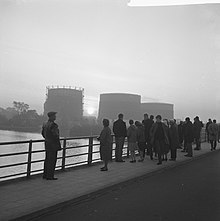Comet Ikeya–Seki
First observed as a faint telescopic object on 18 September 1965, the first calculations of its orbit suggested that on October 21, it would pass just 450,000 km (280,000 mi) above the Sun's surface, and would probably become extremely bright.The three pieces continued in almost identical orbits, and the comet re-appeared in the morning sky in late October, showing a very bright tail.[10] Nonetheless, Ikeya–Seki's increasing luminosity remained apparent;[8] in the Southern Hemisphere, where visibility of the comet was most favorable around the time of perihelion, observers reported Ikeya–Sekit to be as bright as magnitude 0 by 18 October.[8] The two components of Ikeya–Seki's fractured nucleus remained apparent with increasing visual separation, moving apart at approximately 14 m/s (31 mph); one was brighter but more diffuse in appearance than the other.[14] Observations obtained by the McMath–Pierce solar telescope at Kitt Peak National Observatory detected emission lines associated with ionized calcium, chromium, cobalt, copper, iron, manganese, nickel, sodium, vanadium, and cyanide in Ikeya–Seki's coma.A Convair 990 operated by NASA out of Hawaii and a Boeing 707 with scientists from Los Alamos National Laboratory were also involved in observational efforts targeting Ikeya–Seki.Elizabeth Roemer remarked of the breadth of observational data in Publications of the Astronomical Society of the Pacific that "There seems no doubt that the appearance of Comet Ikeya–Seki will stand as a landmark in cometary physics.

C/1967 Y1 (Ikeya–Seki)Comet IkeyaComet SekiDiscovered byKaoru IkeyaTsutomu SekiDiscovery siteAlternative designationsOrbital characteristicsObservation arcOrbit typeKreutz sungrazerAphelionPerihelionSemi-major axisEccentricityOrbital periodInclinationLongitude ofascending nodeArgument ofperiapsisApparent magnitudelong-periodmagnitudeGreat CometSolar SystemKreutz sungrazersa large comet which broke up in 1106Amsterdamtyphoonfavorably clearα HydraeaccelerationFred WhippleSmithsonian Astrophysical Observatorysungrazing cometorbital propertiesGreat Comet of 1882light curvealtitudenaked eyefull MoonMauna Kea, HawaiiarcminutesnucleusZdenek SekaninaUnited States Geological Surveyexposurereflector telescopeUnited States Naval Observatory Flagstaff StationMcMath–Pierce solar telescopeKitt Peak National Observatoryemission linescalciumchromiumcobaltcoppermanganesenickelsodiumvanadiumcyanideLick ObservatoryHaute-Provence Observatoryspectrographic observationsSpectrogramsWhite Sands Missile RangeultravioletWallops IslandHarvardradio emissionConvair 990HawaiiBoeing 707Los Alamos National LaboratoryGemini 6AAgena target vehicleElizabeth RoemerPublications of the Astronomical Society of the PacificJames W. Youngvisible lightHorizonsbarycenterJet Propulsion LaboratoryBibcodeJPL Small-Body DatabaseCometsAntitailComet dustMeteor showerPeriodicNumberedLong periodHalley-typeJupiter-familyMain-beltNon-periodicNear-parabolicHyperbolicUnknown-orbitSungrazingKreutzExtinctExocometInterstellarNaming of cometsObservational history of cometsLINEARExtraterrestrial atmosphereOort cloudSmall Solar System bodyAsteroidList of missions to cometsList of comets visited by spacecraftC/2024 S1 (ATLAS)C/2024 G3 (ATLAS)C/2023 P1 (Nishimura)C/2023 H2 (Lemmon)C/2023 E1 (ATLAS)C/2023 A3 (Tsuchinshan–ATLAS)C/2022 E3 (ZTF)C/2021 O3 (PanSTARRS)C/2021 J1 (Maury-Attard)C/2021 A1 (Leonard)C/2020 F8 (SWAN)C/2020 F5 (MASTER)C/2020 F3 (NEOWISE)